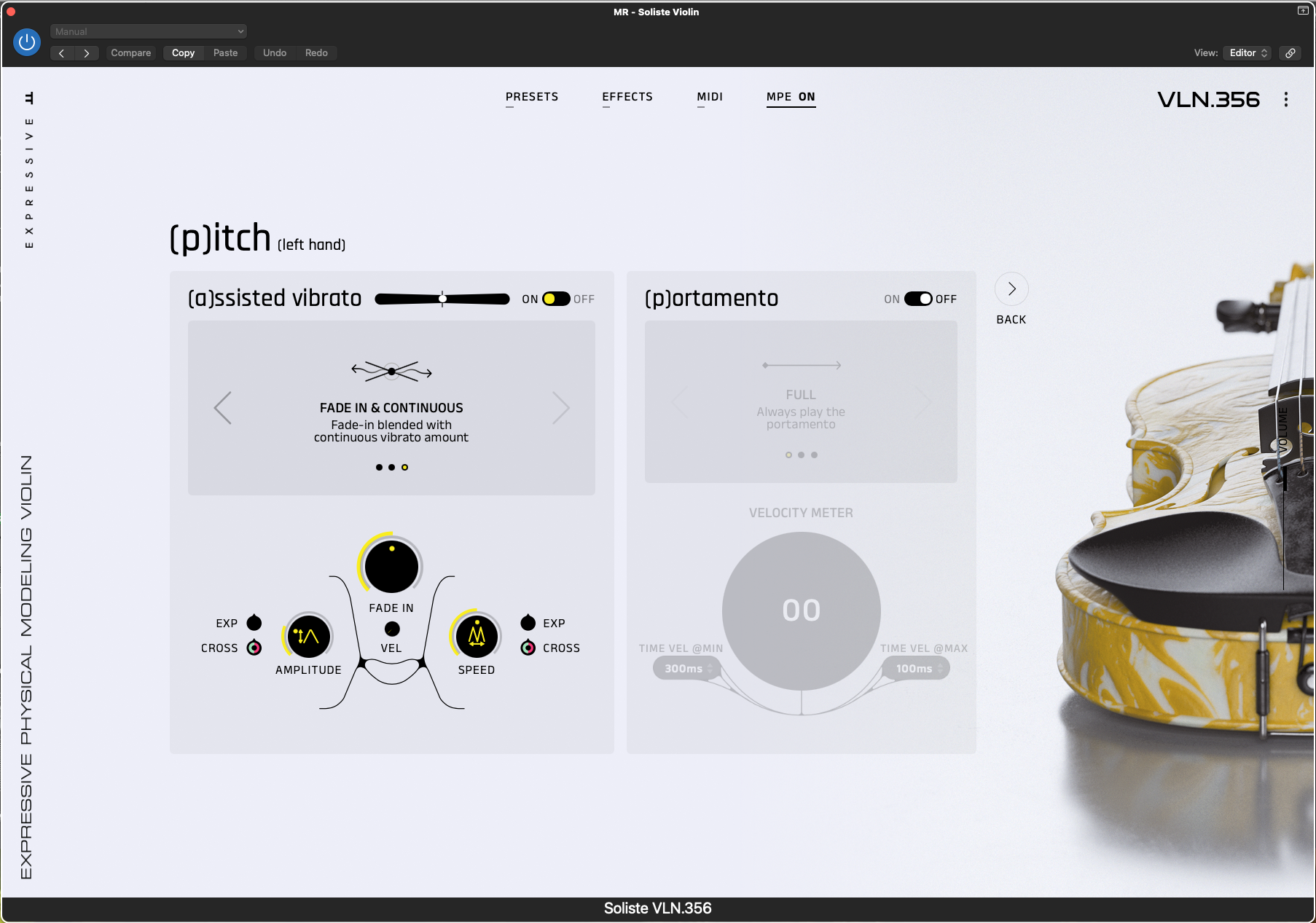
What is it?
Thank goodness for companies that like to push the envelope, especially when such blue-sky thinking yields interesting instruments and sound design, and Expressive E is just such a company, with a penchant for creating tools which allow the player to interact with the instrument, especially through the use of MPE. It developed the unique Touché controller, and latterly the Osmose; a product of keyboard-like proportions, that provides enormous layers of control and expression through MPE.
Its latest software, Soliste, offers a suite of string instruments, each physically modelled to resemble a violin, viola, cello and double bass. It won’t come as a surprise to learn that these instruments have been designed with the Osmose (or other MPE controllers) in mind, but also provide considerable controllability if used with conventional MIDI controllers, particularly if you have a bank of MIDI faders to hand. First and foremost, Soliste is designed to be played live, but thanks to the DAW domain, editing can be fully embraced, particularly if correcting mistakes as you go.
Performance
Plenty of us use string sample libraries when trying to create acoustic or orchestral textures. The technology has really come of age, providing plenty of expression through the use of realistically sampled sounds, in both ensemble and solo camps.
Soliste differs somewhat, as the sound is modelled, meaning that the source is not captured from an original acoustic instrument, instead being generated in real time. This arguably places a greater loading on your computer’s CPU, but can yield a significant amount of control over the sound you play.
We begin by loading VLN.356, which is the highest instrument available, modelling a violin. We auditioned these plugins using an Osmose, alongside a more conventional MIDI controller, giving us access to all of the features available. Upon playing, the resulting sound is very striking. There is a certain resonant quality, which is quite strident and cutting. Playing via the Osmose, a degree of manual dexterity is required; in initial audition, elements such as pitch and vibrato feel very lively, and Expressive E is quick to suggest settings to lessen the pitch variation and impact. Osmose is also a unique interface in its own right, and you have to spend some time with it to adjust your playing style, commanding its various quirks.

Paging Dr Violin
The plugin presentation is clear and concise, with the initial page providing pitch and vibrato control to the left, and bowing control to the right, just like a violinist!
If using an Osmose, you have capacity to move your finger laterally, to induce a relatively natural vibrato and variation of pitch. This definitely feels like a sensible option, as the onboard Soliste vibrato can feel a little automated, albeit with independent controls for speed and amplitude. You can access further controls relating to vibrato and indeed portamento, by clicking on the menu button within this section, at which point there are further permutations to lessen or extend the impact.
Moving over to the right-hand side, the bowing parameters are very extensive and really engaging. When using a MPE controller, it is possible to engineer a bow movement through the pressing and releasing of a note on your keyboard. This is particularly ingenious, as it allows faster bowing techniques from the keyboard. A tremolo option is coupled with pitch variation, meaning that you can induce a subtle detuning, as the bowing continues.

Body matters
You cannot miss the beautiful graphic, representing each instrument, residing in the centre of the instrument’s user interface. Expressive E has modelled a number of different instrument timbre, through six different body and cavity types. These range from relatively hard and abrasive colours, to mellow and antique effects. These can feel quite subtle, upon first listen, but even so your choice should be informed by the type of music you are writing or producing.

Menu diving
One particularly nice feature, is that the main interface has been kept fairly minimal and clean. Don’t be fooled though, because there are a considerable number of settings and options available, through various menus.
Menu access at the top of the plugin includes the Presets menu, providing a number of adjectives and assignments that will help you select an appropriate instrument flavour. It’s a guided menu, using a selection process from the right-hand side, coupled with a character section. This proved to be a helpful starting point, to unravel Soliste’s inner details. It’s also the perfect place to visit if you want to explore different bowing techniques. Apart from the more usual Arco and Pizzicato, you can also choose from Sul Ponticello/Tasto, Tremolo, Bartok and Col Legno articulations, in a category which is described as ‘Specific’, although these articulations may be better described as sustained. There are also five extremely short articulations, such as Spiccato and Staccatissimo.
Effects are also included, as is a full MIDI setup page, which proves very useful when working outside of the MPE format.

The quartet
The other instruments, in the shape of viola, cello and double bass, mirror the design and settings of the violin. As we ventured lower in pitch, through the instrument family, we tended to feel that the violin and viola provided the most authentic performance. By the time we got to the double bass, there seems to be a brightness in the modelling which doesn’t feel overly authentic. The bowing in the cello also had a capacity to feel more accentuated, although with some tweaking, this could be lessened.
All of the instruments adhere to their expected instrumental registers, although the double bass provides an extension down to a low C. The lowest open strings, in each case, do not engage vibrato, as would be the case with a real-world string player.
It is tempting to want to complete the Soliste family, as a prospective purchase, but it is also possible to buy the individual instrument components separately, for a mere €99 each. This is worth considering, as not everyone will require a modelled double bass. In fact, in our experimentation, we found that we could get some very fine results by partnering elements such as the violin, with other existing sample libraries. Of course, this entirely depends on the effect you are trying to reproduce, but there is a purity to the Soliste sound, which can help fool the ear, when partnered alongside section-based samples.
The finale
There is undeniably something pleasing about modelled instrumental plugins. Soliste provides boundless amounts of control, and we particularly enjoyed the engagement perspective, speaking as performing musicians.
We are however less convinced with Soliste’s capacity to sound truly acoustically authentic. Playing an acoustic string instrument is fraught with humanistic imperfection, and while there are elements of this included in the modelling, some aspects, particularly relating to pitch and vibrato, tend to give the game away. One overwhelmingly weak point relates to legato phrasing and articulation, which just doesn’t sound like the real McCoy.
Playing an acoustic string instrument is fraught with humanistic imperfection
To use an analogy which we can all identify with, it’s a little bit like a heavily pitch-corrected vocal, or even one that has been placed through a vocoder; it sounds realistic, but in a strangely different way that you can’t quite put your finger on, and that’s our conclusion with Soliste. Whether this is a positive or negative asset, completely depends on the way you intend to use Soliste, and indeed the style of music that you write. In contemporary and commercial settings, this will sound amazing, but in classical or soundtrack settings, it will take quite a bit of work to make it sound like an acoustic facsimile, and is likely to still fall short. Partnering with other sample libraries is a great idea though, and one worth considering if you really want to highlight the transient nature of your music.
Verdict
Soliste is a fine example of modelling software, providing some really engaging sounds, particularly for the contemporary domain. If you are looking for an acoustic clone, MPE becomes fairly essential, but you’ll need to put the hours in to get the best results.
Hands-on demos
Expressive E
Alternatives
Specifications
Price |
€299 |
Key features |
Four acoustically modelled string instruments Includes plenty of bowing articulations Unique levels of control, through various menus The use of an Osmose, or other MPE controller, would be beneficial! |
System requirements |
Mac & PC – VST2/3 & AU plugin formats |
Contact |







